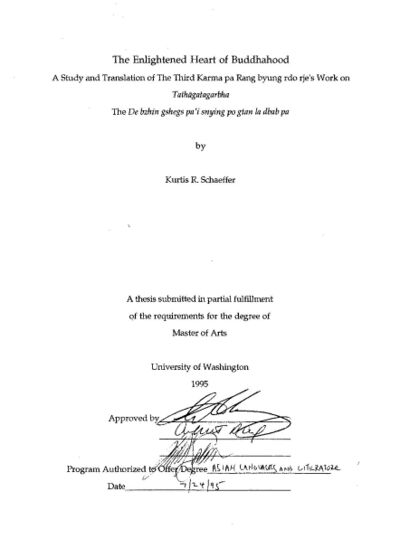The present work is a study of tathāgatagarbha (often referred to as Buddha Nature) thought, crystallized in a short text by one of the great religious scholars of fourteenth-century Tibet, the Third Zhwa nag Karma pa of the Bka' brgyud school, Rang byung rdo rje (1284-1339). This verse text, entitled "A Pronouncement on the Enlightened Heart of Buddhahood" (De bzhin gshegs pa'i snying po gtan la dbab pa, or De bzhin gshegs pa'i snying po bstan pa) blends scriptural quotations from both sūtra and tantra with Rang byung's own words, creating an evocative picture of the relation between the primordially pure enlightened state- symbolized by the Enlightened Heart (snying po)- human existence, and Buddhahood. While Rang byung has relied heavily on the Ratnagotravibhāgaśāstra, (known in Tibet as the Uttaratantra, or Rgyud bla ma), the syncretism of various strands of Mahāyāna and Vajrayāna apparent in the text is particular to Tibet. Tathāgatagarbha, Madhyamaka, Yogācāra, Mahāmudrā, and Annuttarayogatantra all coalesce in this work, which is a testament to the hundreds of years of appropriation and synthesis of Indian and Tibetan Buddhist thought that preceded it.
The leitmotif of the Snying bstan is the indivisibility of the transcendent,
absolute nature of reality and the immanent, ordinary human mode of reality.
This indivisibility is embodied in the concept of the Enlightened Heart (snying po).
To paraphrase, it is precisely because all beings possess the Enlightened Heart of Buddhahood that they are, but for obscuring defilements, essentially Buddhas.
The Snying bstan falls somewhere between religious poetry and religious
philosophy: On the one hand it is evocative, promoting faith in the reader with
striking imagery and a derision of reason as a means to apprehend the absolute.
On the other hand it does attempt to systematize the relation between the
absolute reality and ordinary human reality, arguing against other views of this relation, and methodically describing the continuum of existence from ordinary
human existence to Buddhahood.
This study consists of seven chapters. Chapter one is a paraphrase of the
earliest known biography of Rang byung, the Red Annals (Deb ther dmar po).
Chapter two is a description of Rang byung's textual corpus, in which I have
very briefly described all of the texts attributed to him which I have been able to
locate at the University of Washington.
Chapter three is a short discussion of the historical and doctrinal relation
between Rang byung and Dol po pa Shes rab rgyal mtshan (1292-1361),
generally recognized as the initiator of the gzhan stong (emptiness of other)
system. While later Tibetan scholars such as ['Jam mgon Kong sprul blo 'gros mtha' yas (1813-1899) assimilate these two thinkers, referring to them both as
Gzhan stong pas, differences can be discerned in their thought. This chapter
merely begins to untangle a complicated relationship that will require a
considerable amount of research in order to provide anything approaching a
complete picture.
Chapter four is an explication of the ideas of the Snying bstan. In brief, the
Enlightened Heart (snying po) is present as a precondition for human existence,
throughout human existence, and at the time of awakening, of. Buddhahood. In
order to highlight this idea I will present the thought of Rang byung's work in a
four-fold interpretive model which is intended to represent the existential
moments or phases through which the Enlightened Heart moves, all the while
remaining unchanged from an absolute standpoint by this movement. These
moments are:
1. The pre-phenomenal. The Enlightened Heart as a pre-condition for existence.
2. The phenomenal. The Enlightened Heart obscured within our ordinary
consciousness.
3. The post-phenomenal. The Enlightened Heart revealed at the time of
Buddhahood.
4. The re-phenomenal. Buddhahood acting in the world to aid beings, in a
manner in which the Enlightened Heart is not obscured.
While I have drawn inspiration from certain traditional interpretive schemes, I
have developed this model independently of anyone Tibetan sheme in order to
highlight the relationships posited in the Snying bstan between the Enlightened
Heart and ordinary consciousness.
Throughout this four-fold movement the Enlightened Heart is the
unchanging force compelling human beings toward enlightenment. It is equally
present in all stages, albeit unseen in the phenomenal phase. Although this fourfold scheme is not explicitly stated in the text, it has the advantage of clearly
presenting the relationship between the Enlightened Heart, ordinary human
existence, and Buddhahood.
Chapter five continues the interpretive discussion begun in chapter four.
Specifically, it deals with the use of language in the Snying bstan in terms of the
tension between apophatic or negative language and kataphatic or positive
language as means to refer to the absolute. This topic has a long history in
western thought, especially Eastern Christianity and Neo-Platonism. David
Seyfort-Ruegg has recently described tathagatagarbha as a kataphatic term. I
would like to expand upon his work by suggesting that within the Snying bstan
the Enlightened Heart is elicited through both kataphatic and apophatic
language.
Chapter six is an annotated translation the work, which I have titled in
English The Pronouncement on the Enlightened Heart of Buddhism.
Finallly, chapter seven presents a diplomatic edition of the Snying bstan, as well as the commentarial annotations to the text written by the fifth
Zhwa dmar Dkon mchog yan lag (1525-1583), otherwise known as Dkon mchog 'bangs. (Schaeffer, introduction, 1–4)

